Flood
North Jakarta's unrelenting sinking problem
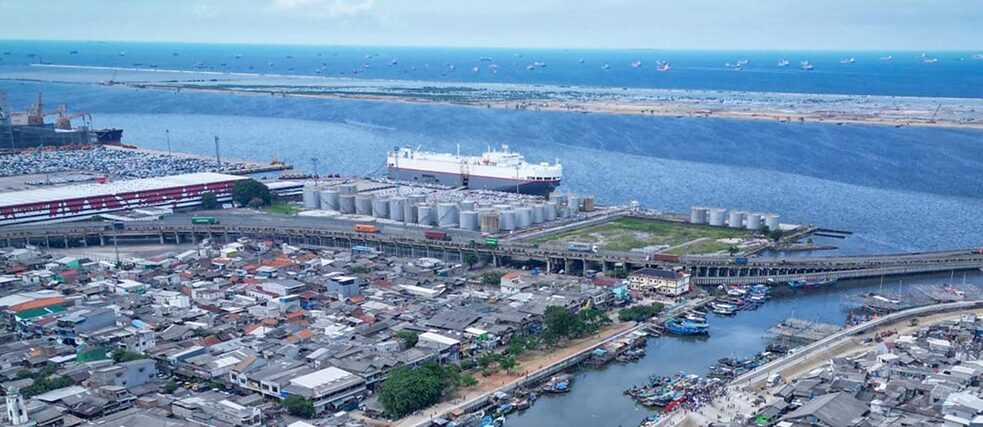
Year after year, Jakarta sinks a few centimetres further below sea level. Flooding is on the rise, while many residents still inhabit the city’s most vulnerable areas. Indonesian journalist Dewi Safitri sheds light on the origins of this tragic situation and how many impoverished people find themselves without other choices.
The Netherlands is renowned for its system of canals, establishing a reputation as experts in canal architecture and water supply management. However, in Jakarta, once named Batavia by the Dutch colonials, there is limited evidence to support this claim. It’s not just expertise that’s being called into question; one study indicates that Dutch colonial policies have, in fact, contributed to the gravest threat facing Jakarta today: land subsidence along the northern coast of the island of Java.
During the colonial era, the Dutch constructed canals that connected the city centre with the outlying areas, where communities of native residents were located, including what is now North Jakarta. These canals served as the primary source of surface water for daily needs, but their proximity to the river’s estuary led to frequent accumulation of sediment deposits, resulting in blockages. Due to lack of cleaning and maintenance, these canals developed foul odours under the city’s high temperatures and became a breeding ground for diseases like cholera.
While the colonial European and affluent native residents had their water needs met through piped water systems, the underprivileged lacked access to such amenities. This issue persisted for over a century, and it was only nearing the 1900s that wells and water tanks began to be constructed in the coastal areas of Jakarta. At the end of the 19th century, residents were permitted to dig for groundwater. The exploitation of groundwater for clean water has continued to this day. More viable options for water provision, such as canal redevelopment and the establishment of piped distribution systems for clean water, have failed to materialise.
Sinking Land and Contaminated Water
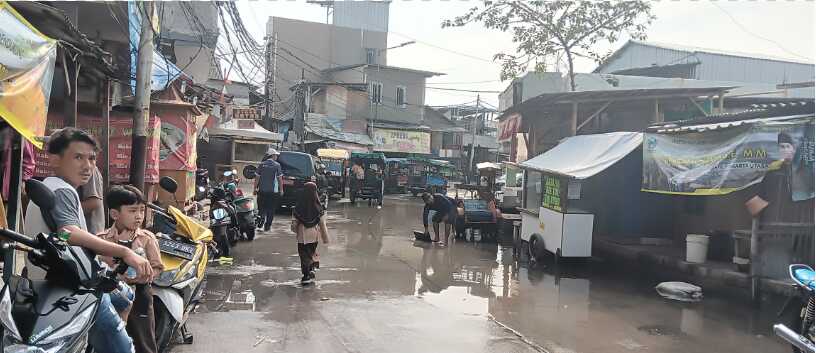
Tidal floods result in prolonged inundation of residential areas affected by severe land subsidence. | © Dewi Safitri
Originally state-owned land, Kampung Empang has been occupied by residents who eventually obtained official building permits. "We may be poor, that's a fact. But we are not illegal; we have the permits," asserted Munarto, the administrative head of RT 03 in the same village. Over the past decade, Munarto and several community leaders from Kampung Empang have met with local officials, including the Governor, urging the installation of pipelines to provide clean water from the regional water company, PAM Jaya. Regrettably, to this day, no pipelines have been implemented in Kampung Empang. The local government has provided a few water kiosks supplied by PAM Jaya's tanks. Residents have to queue and pay 400 rupiah per litre for water. They have also voiced their discontent, claiming that the number of kiosks is insufficient.
In recent decades, scientists have revealed the connection between water issues and increasing inland flooding from the sea in North Jakarta with the assistance of satellite imagery. Prolonged groundwater extraction over centuries has caused the aquifer layer, which holds water in the ground, to become infiltrated with contaminated sea water. This is the layer that residents tap into to access water. With continued excavation, the aquifer layer diminishes, resulting in land subsidence.
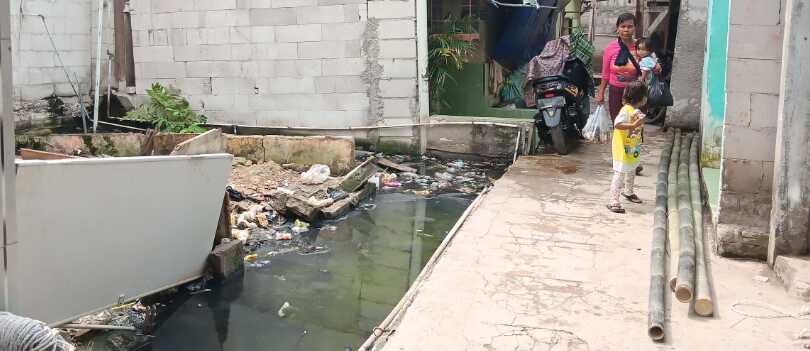
Vacant lots throughout the area are filled with stagnant floodwater. | © Dewi Safitri
"Ceasing groundwater extraction is the best course of action," Heri stated. "What makes the problem complex is the lack of alternatives to groundwater exploitation. If the extraction of groundwater is halted, the supply of clean water will dwindle due to the contamination of both surface water and shallow aquifers."
The Threat of Sinking in 2050

Warsita and his refrigerator perched on a concrete “throne” to evade floodwaters. | © Dewi Safitri
In the kitchen, Karmi adjusts the water hose. "We buy this water, two hundred and forty grand per month. We only use it for bathing and washing clothes, because it’s got a yellow tint," she says. The water is transported through a rubber hose about the size of an adult's wrist from a neighbour’s well about 50 metres away. "For cooking, we buy jugs of mineral water; it’s better,” she says with a weary smile.
Warsita and Karmi's account highlights the prevailing practice of groundwater extraction in North Jakarta. As the reserves of clean water in shallow aquifers have been depleted, drilling must now reach depths of at least 130 metres to access higher quality water. Consequently, the construction of one well can now cost 50-60 million rupiah. Studies conducted by Heri Andreas and his colleagues indicate that if this practice continues, 50 per cent of North Jakarta's area will be submerged by 2050. Other coastal areas in Indonesia, including Semarang, Pekalongan and their environs along the north coast of Java, where groundwater resources have been exploited, are predicted to face a similar fate. With the threat of climate change, rising sea levels, and natural phenomena such as high waves, these regions will experience acute water crises and prolonged tidal floods.
Foreign researchers like Hiroshi Takagi from the Tokyo Institute of Technology have reached similar conclusions. Since embarking on their research seven years ago, Takagi's team has recognised that averting ongoing land subsidence is imperative to address the threat of submergence. The primary strategies involve ceasing groundwater exploitation and implementing building techniques capable of withstanding tidal floods and land subsidence itself.
Unawarness of Imminent Peril
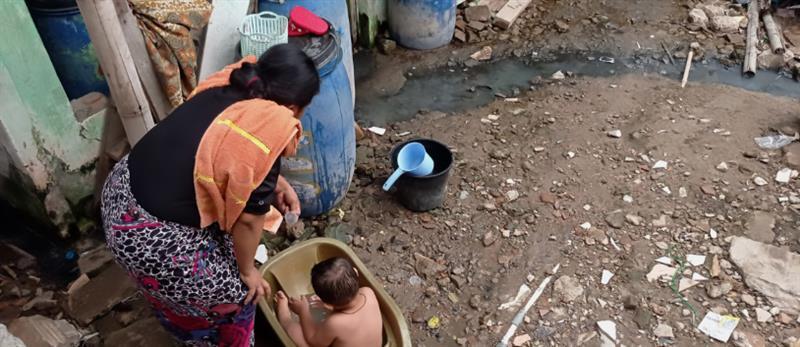
For dozens of years, residents have complained about the unfulfilled promises of piped water and affordable clean water. | © Angga Budhiyantos
I posed the same question to Warsita. He paused for a moment before stating that he had never heard anything about his area sinking. "I have been living here for 15 years, and I haven’t seen any sinking. My house is still standing," he earnestly replied. Warsita's perspective is not an isolated one. Djahruddin, the Secretary of the Pluit Sub-District Office, dismissed the predictions of his area sinking. "Where is the sinking you speak of? Yes, we face monthly floods due to high tides. If you live near the coast, that's normal. How could it suddenly sink?" Djahruddin mentioned the ongoing construction of a massive embankment project (National Capital Integrated Coastal Development - NCICD), spanning 37 kilometres, which will address the flood issues in Muara Angke.
Researchers like Heri Andreas and Hiroshi Takagi doubt that the giant embankment is the ultimate solution to Jakarta's sinking threat. "Yes, in the short term, it’s non-negotiable that the embankment is needed to protect residents from tidal floods. But in the long term, it merely acts as a ‘pain killer’, while the sea level continues to rise and the land sinks further down." There have been many instances of rising seawater breaching the embankment and repeatedly inundating the surrounding areas.
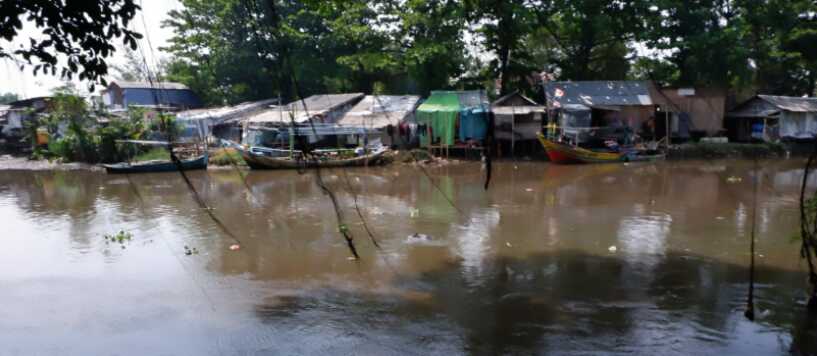
Households that had previously relocated to housing projects (Rusun) have chosen to return due to difficulties in finding work. | © Febiantis
"If no anticipatory measures are taken, the area below sea level would extend to 80 percent within 20 years," writes Lisa Tarigan, Deputy Coordinator of Geological Planning Affairs, Raw Water Conservation, and Provision of Clean Water at the DKI Water Resources Agency. "That's why the DKI Governor Regulation regarding the zoning prohibition of groundwater exploitation is crucial."
However, enforcing this regulation in North Jakarta has proven challenging due to the fact that until last year, only 65 per cent of DKI's regions were served by PAM Jaya. One resident, who preferred not to be identified, expressed frustration with the repeated, unfulfilled promises. "They keep talking about putting in pipes, putting in pipes, putting in pipes. Officials, NGOs, students, journalists – everyone has come. But there's been no change, plain and simple!" he lamented.
According to the Global Risk Report in 2022, Jakarta has earned the unfortunate distinction of being the "Most Vulnerable City" among 576 major cities globally. This label is a result of the imminent perils posed by sinking, pollution, and extensive development. If this scenario were to unfold, the submergence of North Jakarta would directly impact at many as 1.5 million local residents.